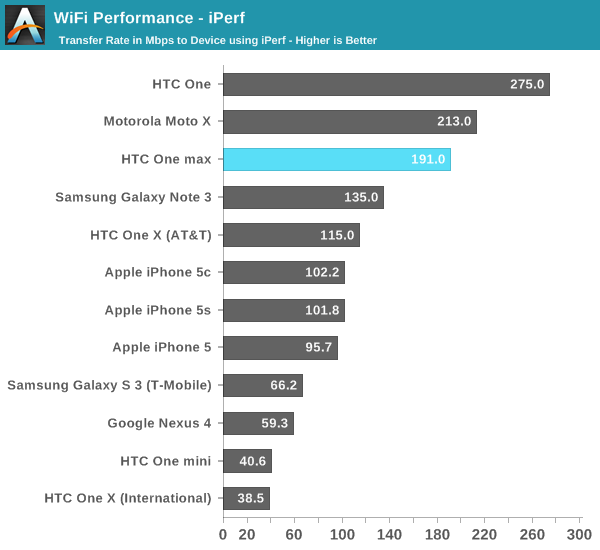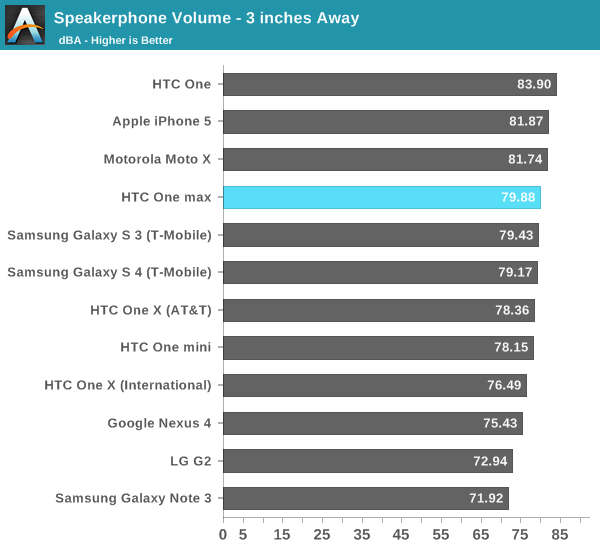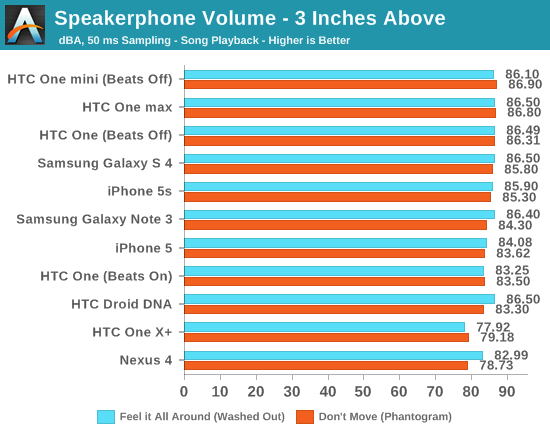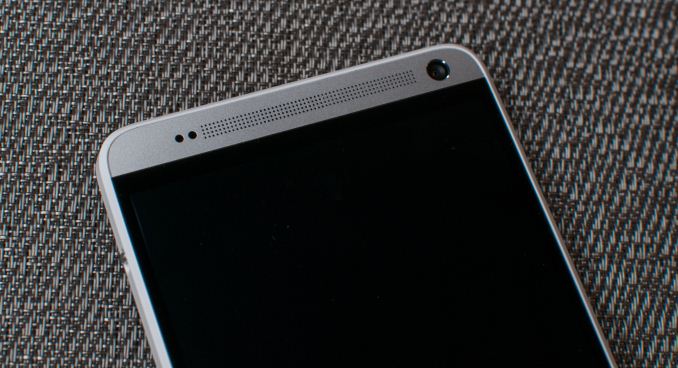HTC One max Review - It's Huge
by Brian Klug on October 28, 2013 10:00 AM EST- Posted in
- Smartphones
- HTC
- Mobile
- One
- Snapdragon 600
- Android 4.3
- One max
Cellular
Cellular on the One max is pretty much the same story as the One, and another shared bullet point. The top and bottom metal cutouts are still the radiative surfaces of the antenna, and there’s still transmit and receive diversity as well to mitigate any unwarranted antenna detuning from holding the device. The unit I was sampled has LTE banding for EMEA (Europe, Middle East, and Africa), but there’s appropriate banding for Asia, Sprint (a tri-mode device with 800/1900 MHz and TDD-LTE on 2600 MHz) and Verizon (700 MHz and AWS), according to the HTC specs page.
The baseband inside the One max is again shared with the One (Qualcomm’s 2nd generation multimode LTE MDM9x15 family), although the One max does have a bit more band support for the USA LTE on Sprint and Verizon, so the front ends are different.
WiFi
Interestingly enough with the One max we see HTC going to Qualcomm Atheros for the WLAN and BT combo, best I can tell this is the WCN3680 which is probably a bit cheaper to include than the BCM4335 we saw in the One. It’s still a single spatial stream 802.11ac capable part, meaning a PHY rate of up to 433 Mbps if you’re in the right channel conditions with 80 MHz channels on 5 GHz. The WCN3680 combo is the 802.11ac successor to WCN3660 which we saw in a number of phones last generation, and is accelerated by the SoC. WCN3680 also does BT 4.0, and FM Rx/Tx if applicable.

To test throughput on the One max I used iPerf the same way I have for a while now. Subjectively there are no complaints from me about WLAN connectivity on the One max, no random dropouts or issues, and Sense 5.5 thankfully still includes the WiFi frequency band manual selection option.
I saw the WCN3680 solution inside Moto X already, it’s interesting to see it in the One max. I believe the One mini uses its 802.11n cousin, WCN3660 as well, probably again for cost reasons.
Speakerphone
Although Beats is gone since that partnership has ended as of the One max, the device still seems to retain everything that made it sound great. There are still the larger-than-typical speaker chambers, big speaker grilles on the top and bottom, stereo sound, and importantly the TFA9887 speaker amplifier and protection part from NXP. In addition there’s still the TPA6185 headphone amplifier as well.
Beats always seemed to be an audio compressor that ran on the DSP, ostensibly through the Hexagon DSP access program or something, and that’s what’s absent on the One max. There’s no toggle under settings for enabling or disabling it, nor the Beats branding, but to be honest I almost always disabled Beats on the One anyways since it was a fair amount louder with it disabled. What made the One great was all the hardware behind the speakers, not so much the software compressor.


The One max goes plenty loud just like the original One. I went ahead and added the One mini and 5s to the chart too, just to check whether things have changed much, in addition to the Galaxy S 4 and Note 3. The One max basically performs like the One with Beats turned off, which isn’t a surprise since it isn’t there anymore. There’s also no detectable saturation, and the One line remains the only device that doesn’t sound tinny or rattly with overemphasized highs and lacking mids. I suspect the A weighting I selected a while ago for measuring might be a contributing factor as well. Either way you’re not going to be wanting for more loudness on the One max, and the inclusion of front firing stereo speakers makes for a completely different listening experience.












197 Comments
View All Comments
RYF - Tuesday, October 29, 2013 - link
The problem with the relentless rant of commenters with regard of the requirement of the SD card is that they have, in fact, ignored the reality that all will want to stuff their phones with media.My anecdotal observations in my social circle show that they do not need 16GB/32GB+64Gb of storage. It is good to have but they do not need it. And I have received complaints from SGS3 user that the 16GB built in memory has caused a great deal of problems in game app installtion as these apps are not transferrable to SD card.
The demands for SD card slot is okay. There are many phones out there to choose from. But to condemn Brian for expressing his thoughts and to criticitizing the every device manufacturers out there not to have the SD card slot is definitely irrational. We have choices here. And we should respect the different choices.
Sm0kes - Thursday, October 31, 2013 - link
Agreed. Expandability is a feature that many value. I personally don't. To each their own.willis936 - Monday, October 28, 2013 - link
Love the review. I hadn't even heard of this phone coming out.I know it's a bit much to ask this but could you start doing a more intensive audio benchmark suite on phones and tablets? It's very often overlooked but a lot of people will use the devices they keep on them as sources (usually pull down from the cloud) and THD+N and response numbers and graphs would be very helpful in making decisions.
cheinonen - Monday, October 28, 2013 - link
We have something in the works for this. Hopefully it happens soon, because it will be awesome when it does.synaesthetic - Monday, October 28, 2013 - link
Output impedance PLEASE.Impulses - Monday, November 11, 2013 - link
+1000ZeDestructor - Monday, October 28, 2013 - link
Still no review of any Sony gear....Any news on that Brian?
Brian Klug - Monday, October 28, 2013 - link
I'll review it when they send it, still got nothing.-Brian
Myrandex - Monday, October 28, 2013 - link
Too bad that statement doesn't apply to new Nokia phones :/superflex - Tuesday, October 29, 2013 - link
The phone for the 1%.Yeah, everybody's dying to hear about another Windows fail phone